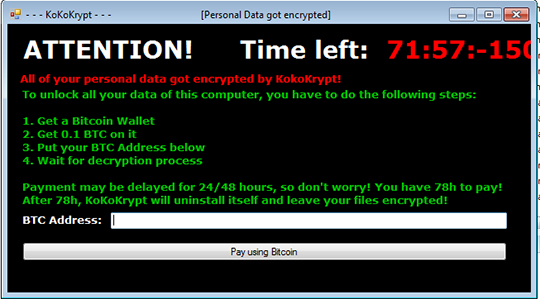RANSOM_HIDDENTEARKOKO.A
Ransom.HiddenTear (Malwarebytes), a variant of MSIL/Filecoder.DS (ESET-NOD32)
Windows


Threat Type: Trojan
Destructiveness: No
Encrypted: No
In the wild: Yes
OVERVIEW
Dropped by other malware, Downloaded from the Internet
This Trojan arrives on a system as a file dropped by other malware or as a file downloaded unknowingly by users when visiting malicious sites.
It is capable of encrypting files in the affected system.
TECHNICAL DETAILS
40,960 bytes
EXE
No
25 Dec 2016
Connects to URLs/IPs, Steals information, Encrypts files
Arrival Details
This Trojan arrives on a system as a file dropped by other malware or as a file downloaded unknowingly by users when visiting malicious sites.
Other Details
This Trojan connects to the following URL(s) to get the affected system's IP address:
- http://tools.{BLOCKED}n.it/php/ip.php
It encrypts files with the following extensions:
- .3dm
- .3g2
- .3gp
- .aaf
- .accdb
- .aep
- .aepx
- .aet
- .ai
- .aif
- .arw
- .as
- .as3
- .asf
- .asp
- .asx
- .avi
- .bay
- .bmp
- .cdr
- .cer
- .class
- .cpp
- .cr2
- .crt
- .crw
- .cs
- .csv
- .db
- .dbf
- .dcr
- .der
- .dng
- .doc
- .docb
- .docm
- .docx
- .dot
- .dotm
- .dotx
- .dwg
- .dxf
- .dxg
- .efx
- .eps
- .erf
- .fla
- .flv
- .idml
- .iff
- .indb
- .indd
- .indl
- .indt
- .inx
- .jar
- .java
- .jpeg
- .jpg
- .kdc
- .m3u
- .m3u8
- .m4u
- .max
- .mdb
- .mdf
- .mef
- .mid
- .mov
- .mp3
- .mp4
- .mpa
- .mpeg
- .mpg
- .mrw
- .msg
- .nef
- .nrw
- .odb
- .odc
- .odm
- .odp
- .ods
- .odt
- .orf
- .p12
- .p7b
- .p7c
- .pdb
- .pef
- .pem
- .pfx
- .php
- .plb
- .pmd
- .pot
- .potm
- .potx
- .ppam
- .ppj
- .pps
- .ppsm
- .ppsx
- .ppt
- .pptm
- .pptx
- .prel
- .prproj
- .ps
- .psd
- .pst
- .ptx
- .r3d
- .ra
- .raf
- .rar
- .raw
- .rb
- .rtf
- .rw2
- .rwl
- .sdf
- .sldm
- .sldx
- .sql
- .sr2
- .srf
- .srw
- .svg
- .swf
- .tif
- .vcf
- .vob
- .wav
- .wb2
- .wma
- .wmv
- .wpd
- .wps
- .x3f
- .xla
- .xlam
- .xlk
- .xll
- .xlm
- .xls
- .xlsb
- .xlsm
- .xlsx
- .xlt
- .xltm
- .xltx
- .xlw
- .xml
- .xqx
- .zip
- .txt
It renames encrypted files using the following names:
- {Original File path and File name}.kokolocker
It does the following:
- Gathers the following Information:
- Computer Name
- User Name
- Current Status (Locked\Unlocked)
- IP Address
- Inputted BitCoin Address
- Encrypts files from the following folder(s):
- C:\Batch
- Displays the following GUI:

It is capable of encrypting files in the affected system.
SOLUTION
9.800
13.116.02
25 Dec 2016
13.117.00
26 Dec 2016
Step 1
Before doing any scans, Windows XP, Windows Vista, and Windows 7 users must disable System Restore to allow full scanning of their computers.
Step 2
Note that not all files, folders, and registry keys and entries are installed on your computer during this malware's/spyware's/grayware's execution. This may be due to incomplete installation or other operating system conditions. If you do not find the same files/folders/registry information, please proceed to the next step.
Step 3
Identify and terminate files detected as RANSOM_HIDDENTEARKOKO.A
- Windows Task Manager may not display all running processes. In this case, please use a third-party process viewer, preferably Process Explorer, to terminate the malware/grayware/spyware file. You may download the said tool here.
- If the detected file is displayed in either Windows Task Manager or Process Explorer but you cannot delete it, restart your computer in safe mode. To do this, refer to this link for the complete steps.
- If the detected file is not displayed in either Windows Task Manager or Process Explorer, continue doing the next steps.
Step 4
Scan your computer with your Trend Micro product to delete files detected as RANSOM_HIDDENTEARKOKO.A. If the detected files have already been cleaned, deleted, or quarantined by your Trend Micro product, no further step is required. You may opt to simply delete the quarantined files. Please check this Knowledge Base page for more information.
Step 5
Restore encrypted files from backup.
Did this description help? Tell us how we did.

